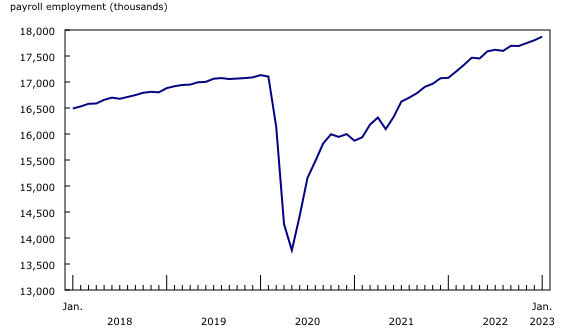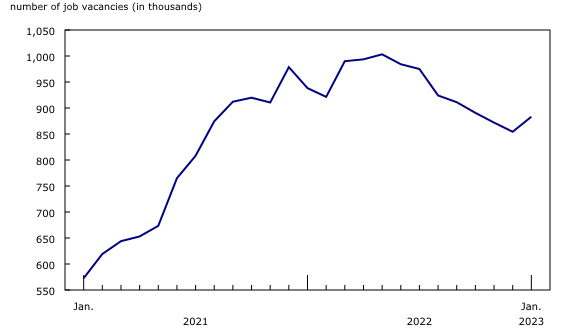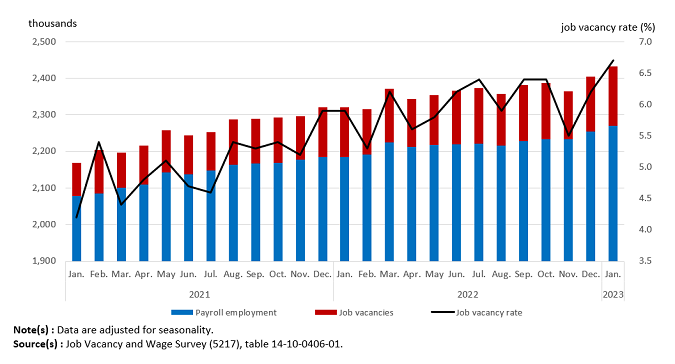Payroll employment, earnings and hours, and job vacancies, January 2023
Released: 2023-03-30
$1,185.39
January 2023
2.9% 
(12-month change)
$1,175.09
January 2023
5.3% 
(12-month change)
$992.10
January 2023
3.2% 
(12-month change)
$1,033.89
January 2023
2.9% 
(12-month change)
$1,079.32
January 2023
4.3% 
(12-month change)
$1,140.91
January 2023
3.8% 
(12-month change)
$1,217.02
January 2023
2.7% 
(12-month change)
$1,086.24
January 2023
5.0% 
(12-month change)
$1,157.42
January 2023
1.9% 
(12-month change)
$1,268.44
January 2023
1.6% 
(12-month change)
$1,182.48
January 2023
2.4% 
(12-month change)
$1,338.48
January 2023
0.6% 
(12-month change)
$1,576.33
January 2023
-2.0% 
(12-month change)
$1,616.58
January 2023
2.1% 
(12-month change)
The number of employees receiving pay or benefits from their employer—measured as "payroll employees" in the Survey of Employment, Payrolls and Hours—rose by 71,100 (+0.4%) in January, following an increase of 53,700 (+0.3%) in December 2022. Overall payroll employment has generally trended upwards over the previous five months, resulting in cumulative gains of 275,400 (+1.6%) from September 2022 to January 2023.
Payroll employment increased in six provinces in January, with the largest gains observed in Ontario (+17,700; +0.3%), Alberta (+14,500; +0.7%) and Quebec (+13,900; +0.3%).
Payroll employment increases in the services-producing sector
Payroll employment in the services-producing sector increased by 79,000 (+0.6%) in January. Gains were recorded in 12 of the 15 sectors, led by retail trade (+22,700; +1.1%), transportation and warehousing (+12,800; +1.6%) and public administration (+10,000; +0.8%). Meanwhile, payroll employment declined in information and cultural industries (-11,200; -2.9%) in January.
Payroll employment in the goods-producing sector recorded little change in January. However, a decrease was observed in the construction sector (-7,600; -0.7%), including non-residential building construction (-2,700; -2.2%) and building equipment contractors (-2,100; -0.7%).
Payroll employment increases in retail trade for the first time since September 2022
In January 2023, payroll employment in retail trade increased by 22,700 (+1.1%), the first monthly increase since September 2022. Monthly gains in January 2023 were recorded in eight provinces, including Ontario (+7,800; +1.1%) and Quebec (+5,700; +1.2%). Meanwhile, payroll employment in the sector was little changed in Manitoba and Prince Edward Island.
Nationally, 7 of the 9 subsectors in retail trade recorded monthly gains in January, with food and beverage retailers (+15,100; +2.9%) posting the largest payroll employment increase.
Payroll employment in transportation and warehousing increases for the eighth consecutive month
Payroll employment grew by 12,800 (+1.6%) in transportation and warehousing in January, increasing for the eighth consecutive month, bringing the total gain to 36,900 (+4.6%) since June 2022. Increases were recorded in six provinces in January 2023, led by Ontario (+4,900; +1.6%), Alberta (+4,600; +4.1%) and Quebec (+2,100; +1.2%). Year over year, the sector grew by 50,200 (+6.4%) nationally in January.
In January, increases in payroll employment were recorded in 5 of the 11 subsectors, led by truck transportation (+6,500; +3.0%) and rail transportation (+3,100; +8.1%). These two subsectors made up less than one-third of payroll employment in transportation and warehousing in January (31.3%), but accounted for around three-quarters of the sector's monthly growth (+74.8%).
Payroll employment in public administration continues an upward trend in January
Payroll employment in public administration (+10,000; +0.8%) increased for the seventh consecutive month in January, bringing the total gain to 48,600 (+4.0%) since July 2022. The largest monthly gain in January 2023 was recorded in local, municipal and regional public administration (+7,500; +1.6%).
In January, five provinces recorded payroll employment increases in public administration, led by Ontario (+4,600; +1.0%), Saskatchewan (+1,500; +2.8%) and British Columbia (+1,400; +0.9%).
Goods-producing sector drives year-over-year growth in average weekly earnings in January
On a year-over-year basis, average weekly earnings grew 2.9% to $1,185 in January. Growth in January 2023 was higher than in December 2022 (+2.6%), but lower than in November 2022 (+4.0%). Growth in average weekly earnings can reflect a range of factors, including changes in wages, composition of employment and hours worked.
Year over year, average weekly earnings in the goods-producing sector increased by 5.8% in January 2023. Robust gains were recorded in utilities (+7.8% to $2,058), construction (+6.4% to $1,497) and forestry and logging (+6.2% to $1,348).
In January, average weekly earnings in the services-producing sector (+2.3%) grew at a slower pace year over year compared with the goods-producing sector. Stronger gains in real estate and rental and leasing (+8.9% to $1,293) and finance and insurance (+8.8% to $1,634) were tempered by slower growth in public administration (+1.4% to $1,512) and a decline in retail trade (-1.7% to $682).
In January, year-over-year employment growth (+4.6%) outpaced growth in total hours worked (+3.8%), resulting in a 0.9% decline in average weekly hours to 33.3 hours. The forestry and logging sector (+7.3% to 42.4 hours) posted the largest year-over-year increase in average weekly hours in January, while arts, entertainment and recreation (-6.8% to 24.7 hours) recorded the largest decrease.
Job vacancies up in January after trending down since June 2022
Job vacancies increased 3.4% (+29,000) in January 2023, led by transportation and warehousing (+14,500) and health care and social assistance (+12,400). Concurrently, job vacancies decreased in professional, scientific and technical services (-6,200; -10.9%), manufacturing (-4,200; -6.0%) and educational services (-3,800; -14.1%).
Overall, there were 883,200 job vacancies across all sectors in January. The monthly increase in January follows a general downward trend from June to December 2022. Compared with the peak reached in May 2022, job vacancies were down 12.0% (-120,000) in January 2023.
The job vacancy rate—which corresponds to the number of vacant positions as a proportion of total labour demand (the sum of filled and vacant positions)—was 4.9% in January 2023, little changed from December 2022.
There was an average of 1.2 unemployed persons for every job vacancy in January 2023. This ratio has remained virtually unchanged since August 2022. According to the Labour Force Survey, the unemployment rate held steady at 5.0% in January and February 2023.
Job vacancies reach a record high in health care and social assistance
The number of job vacancies in health care and social assistance increased by 12,400 (+8.3%) in January to reach 162,100, the highest level on record.
Compared with the previous record high reached in July 2022 (152,800), growth in total labour demand in January 2023 in health care and social assistance (+58,200; +2.5%) has outpaced growth in payroll employment (+48,900; +2.2%), resulting in a new record high job vacancy rate (6.7%) in January.
Job vacancies up in four other sectors
The number of job vacancies in transportation and warehousing rose (+14,500; +41.2%) to 49,600 in January, offsetting the decrease recorded in December 2022 (-12,300; -26.0%). On a year-over-year basis, the number of vacancies in the sector showed little change in January 2023, while payroll employment increased by 42,900 (+5.5%).
The number of vacancies also rose in January 2023 in administrative and support, waste management and remediation services (+10,600 to 53,900), information and cultural industries (+2,500 to 15,700), and real estate and rental and leasing (+2,400 to 12,300).
Job vacancies decline in professional, scientific and technical services, manufacturing and educational services
There were 50,700 job vacancies in the professional, scientific and technical services sector in January, down by 6,200 (-10.9%) from December 2022, and down by 22,800 (-31.0%) from the record high reached in April 2022.
The job vacancy rate in professional, scientific and technical services was 4.0% in January 2023, down by 0.5 percentage points from December 2022. It was 2.1 percentage points lower than the record high of 6.1% reached in April 2022, reflecting the drop in job vacancies in January 2023 combined with an increase in payroll employment (+69,700; +6.1%).
Job vacancies also fell in manufacturing (-4,200 to 66,600) and educational services (-3,800 to 22,900) in January 2023. Educational services (1.6%) had the lowest job vacancy rate of all sectors in January for the ninth month in a row.
Job vacancies hold steady in accommodation and food services, retail trade, construction and eight other sectors
In January, job vacancies held steady in 11 sectors, including 3 sectors which together accounted for nearly one-third (32.7%) of all job vacancies: accommodation and food services (118,900), retail trade (99,100) and construction (71,100).
In accommodation and food services, the job vacancy rate was 8.5% in January, little changed from December 2022 (8.4%). Despite generally trending down in the second half of 2022, the job vacancy rate in accommodation and food services remained the highest across all sectors in January 2023.
Job vacancies climb in Quebec and Newfoundland and Labrador
Job vacancies increased in Quebec (+10,400 to 223,800) and Newfoundland and Labrador (+1,500 to 8,000) in January, while they showed little change in all other provinces. Quebec (5.5%) and British Columbia (5.5%) continued to have the highest job vacancy rates among all provinces, while Newfoundland and Labrador (3.6%) had the lowest.
Sustainable Development Goals
On January 1, 2016, the world officially began implementation of the 2030 Agenda for Sustainable Development — the United Nations' transformative plan of action that addresses urgent global challenges over the next 15 years. The plan is based on 17 specific sustainable development goals.
The Survey of Employment, Payrolls and Hours is an example of how Statistics Canada supports the reporting on the Global Goals for Sustainable Development. This release will be used in helping to measure the following goals:


Note to readers
Survey of Employment, Payrolls and Hours
With the March 30 release of January 2023 estimates, Survey of Employment, Payrolls and Hours (SEPH) is moving to the North American Industry Classification System (NAICS) 2022 Version 1.0. As well, seasonal adjustment factors are being updated. Seasonally adjusted estimates are being revised historically back to 2001. In addition to the new industrial classification system, and new seasonal factors, historical revisions are also being made for a small number of industries (four-digit level of the NAICS).
The key objective of the SEPH is to provide a monthly portrait of the level of earnings, employment and hours worked, by detailed industry, at the national, provincial and territorial levels.
Payroll employment, as measured by the SEPH, refers to the number of employees receiving pay or benefits (employment income) during a given month. The survey excludes the self-employed, owners and partners of unincorporated businesses and professional practices, and employees in the agricultural sector.
SEPH estimates are produced by integrating information from three sources: a census of approximately 1 million payroll deduction records provided by the Canada Revenue Agency; the Business Payrolls Survey, which collects data from a sample of 15,000 establishments; and administrative records of federal, provincial and territorial public administration employment, provided by these levels of government.
Estimates of average weekly earnings and hours worked are based on a sample and are therefore subject to sampling variability. This analysis focuses on differences between estimates that are statistically significant at the 68% confidence level. Payroll employment estimates are based on a census of administrative records and are not subject to sampling variability.
With each release of SEPH data, data for the preceding month are revised. Users are encouraged to use the most up-to-date data available for each month.
Statistics Canada also produces employment estimates from its Labour Force Survey (LFS). The LFS is a monthly household survey, the main objective of which is to divide the working-age population into three mutually exclusive groups: the employed (including the self-employed), the unemployed and those not in the labour force. This survey is the official source for the unemployment rate, and it collects data on the sociodemographic characteristics of all those in the labour market.
As a result of conceptual and methodological differences, estimates of changes from the SEPH and the LFS differ occasionally. However, the trends in the data are similar. For a more in-depth discussion of the conceptual differences between employment measures from the LFS and the SEPH, refer to Section 8 of the Guide to the Survey of Employment, Payrolls and Hours (72-203-G).
Unless otherwise stated, this release presents seasonally adjusted data, which facilitate comparisons because the effects of seasonal variations are removed. For more information on seasonal adjustment, see Seasonally adjusted data – Frequently asked questions.
Non-farm payroll employment data are for all hourly and salaried employees and for the "other employees" category, which includes piece-rate and commission-only employees.
Unless otherwise specified, average weekly hours data are for hourly and salaried employees only and exclude businesses that could not be classified to a NAICS code.
All earnings data include overtime and exclude businesses that could not be classified to a NAICS code. Earnings data are based on gross taxable payroll before source deductions. Average weekly earnings are derived by dividing total weekly earnings by the number of employees.
Job Vacancy and Wage Survey
Job Vacancy and Wage Survey (JVWS) collection is done on a quarterly basis. The quarterly sample of business locations is allocated to the three collection months of the quarter, approximately balanced by province and by industrial sector across each of the three months. This allows both quarterly and monthly estimates to be produced.
Preliminary monthly estimates are produced for job vacancies, job vacancy rates and payroll employment using available responses from business locations sampled in the corresponding reference month. The reference period for the JVWS is the first day of the respective month.
These preliminary monthly estimates are revised and finalized when the corresponding quarterly estimates are released or shortly thereafter. Users are encouraged to use the most up-to-date data available for each month.
Unless otherwise stated, this release presents seasonally adjusted data, which facilitate comparisons because the effects of seasonal variations are removed. For more information on seasonal adjustment, see Seasonally adjusted data – Frequently asked questions.
With this release, seasonally adjusted job vacancy estimates by province are released for the first time (table 14-10-0432-01). Also, seasonally adjusted job vacancy estimates by sector have been revised to the beginning of the series (April 2015).
While JVWS employment is calibrated to the SEPH, SEPH payroll employment and JVWS preliminary monthly employment figures may differ because of calibration grouping and differences in scope and reference period.
The JVWS also provides comprehensive quarterly data on job vacancies by industrial sector and detailed occupation for Canada and the provinces, territories and economic regions; offered hourly wages; and job vacancy characteristics. More information about the concepts and use of data from the JVWS is available in the Guide to the Job Vacancy and Wage Survey (75-514-G).
Real-time data tables
Real-time data tables 14-10-0357-01, 14-10-0358-01, 14-10-0331-01 and 14-10-0332-01 will be updated on April 17.
Next release
February data for the SEPH and the JVWS will be released on April 27.
Products
More information about the concepts and use of the Survey of Employment, Payrolls and Hours is available in the Guide to the Survey of Employment, Payrolls and Hours (72-203-G).
The product "Earnings and payroll employment in brief: Interactive app" (14200001) is now available. This interactive data visualization application provides a comprehensive picture of the Canadian labour market using the most recent data from the Survey of Employment, Payrolls and Hours. The estimates are seasonally adjusted and available by province and largest industrial sector. Historical estimates that go back 10 years are also included. The interactive application allows users to explore and personalize the information presented quickly and easily. Combine multiple provinces and industrial sectors to create your own labour market domains of interest.
Contact information
For more information, or to enquire about the concepts, methods or data quality of this release, contact us (toll-free 1-800-263-1136; 514-283-8300; infostats@statcan.gc.ca) or Media Relations (statcan.mediahotline-ligneinfomedias.statcan@statcan.gc.ca).
- Date modified:



